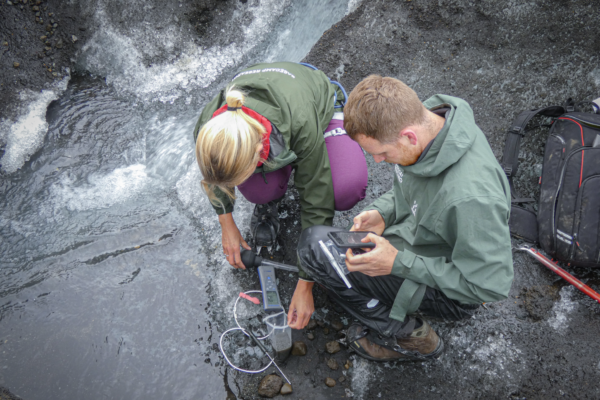Our world’s biodiversity is rapidly declining due to human-induced pressures, posing grave threats to our economic systems and natural ecosystems. Thank you to climate artist Nicole Kelner for this beautiful banner image, which abstractly depicts the 69% decline in wildlife from 1970-2018.
In 2009, Johan Rockstrom of the Stockholm Resilience Center introduced the concept of planetary boundaries, outlining the nine critical environmental system limits within which humanity must remain to live sustainably on this planet.
In September 2023, a team of scientists quantified all nine boundaries for the first time, revealing that six have already been breached. Crossing these boundaries raises the risk of irreversible ecosystem changes, posing threats to people, economies, and natural systems worldwide. Nature is rich with mutualism and reciprocity, and when it becomes unbalanced, biodiversity suffers. But how do we assign economic value to something as nebulous, shared, and (sometimes) invisible as biodiversity?
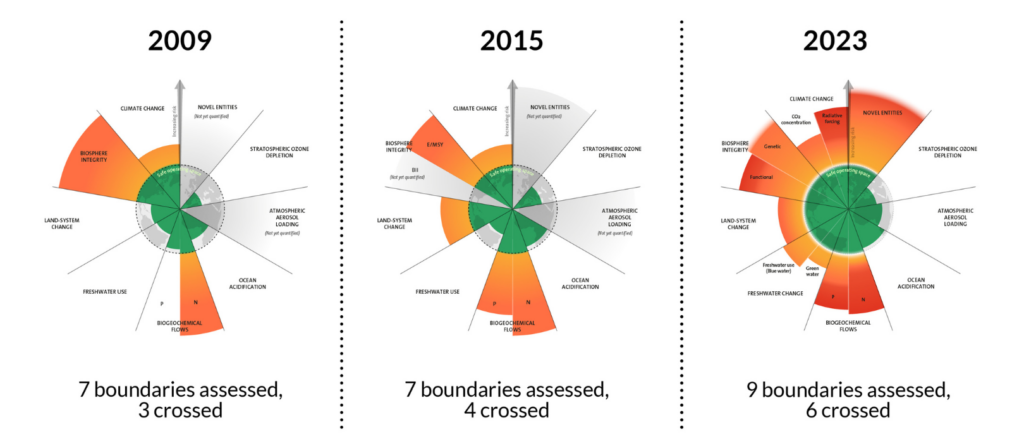
What Is Natural Capital and Why Do We Need It?
Natural capital refers to the inherent economic value and the services rendered to humanity by a specific region’s natural resources and environmental attributes.
The World Economic Forum (WEF) estimated in 2020 that $44 trillion of economic value generation is either moderately or highly dependent on nature. The S&P concluded that 85% of the biggest companies in the world are highly dependent on nature. Examples of this include microbes that stabilize phosphorus and nitrogen in agricultural soils to keep them fertile and how the presence of wild pollinators boosts crop production. The fashion industry, which is a leading contributor to biodiversity decline, is also highly reliant on it, with multiple dependent material supply chains.
Additional estimates from WEF show that the preservation of nature and biodiversity has the potential to yield annual business opportunities valued at $10 trillion.
Agriculture, Forestry, Fishery and aquaculture, Food/beverages/tobacco, and Construction are industries that represent the highest levels of dependency on nature. As a result, over 50% of the market capitalization of companies listed on 19 significant stock exchanges face financial risk due to their high or moderate reliance on nature.
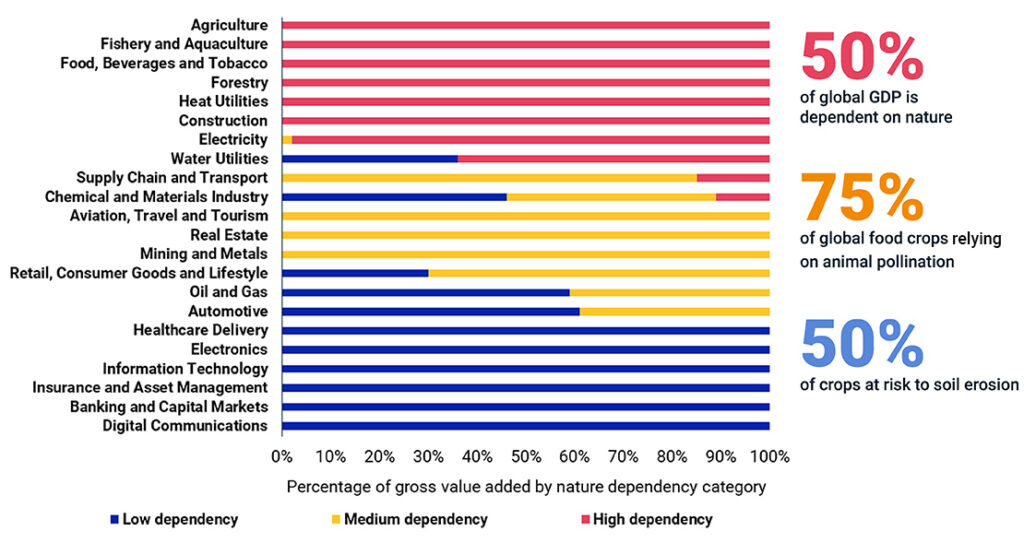
The bottom line is that most industries exhibit a high or moderate level of reliance on nature, whether through core operations or across their supply chains and we simply must begin implementing industrial practices in a way that promotes its safekeeping.
Thankfully, this narrative has begun moving into global political and corporate agendas.
A New Era of Global Biodiversity Agreements and Corporate Accountability
This year at Climate Week New York, the Taskforce on Nature-related Financial Disclosures (TNFD) unveiled their “final” recommendations for nature-related risk management and disclosure. TNFD’s mission is to enhance decision-making for companies and capital providers aiming to drive a significant shift in global financial flows and redirect investments towards nature-positive outcomes.
The document is comprised of 14 disclosure recommendations and implementation guidance measures that align with the requirements of the landmark COP15 agreement that was established in 2022. What is noteworthy is that on the receiving end, companies are adopting TNFD’s recommendations faster than we saw during an earlier released climate change-focused TCFD, indicating an increased industrial maturity and muscle for responding to sustainability.
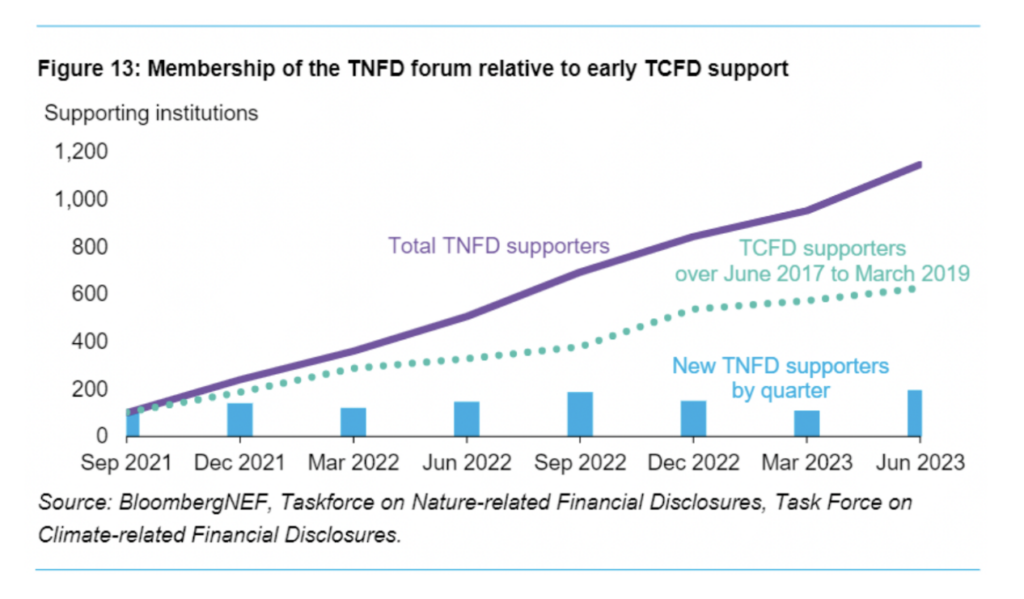
In the European Union, the Corporate Sustainability Reporting Directive (CSRD) is setting the stage for corporate accountability and is affecting approximately 50,000 companies. Starting in 2024, large firms, followed by listed SMEs in 2027, will be required to disclose their strategic sustainability plans. These disclosures must align with global biodiversity goals, including achieving net gain by 2030 and full recovery by 2050.
The Science-Based Targets for Nature (SBTN) initiative, a global coalition of 80+ environmental non-profits and mission-driven organizations, also released the first corporate science-based targets for nature this year.
These targets are designed to support companies in improving their impact on freshwater quality, freshwater quantity, and the protection and restoration of terrestrial ecosystems. SBTN’s plans include the development of methodologies to address marine and aquatic systems based on the latest marine biodiversity science.
With this holistic approach, they aim to tackle key biodiversity pressures and drive meaningful change in safeguarding our planet’s natural heritage.
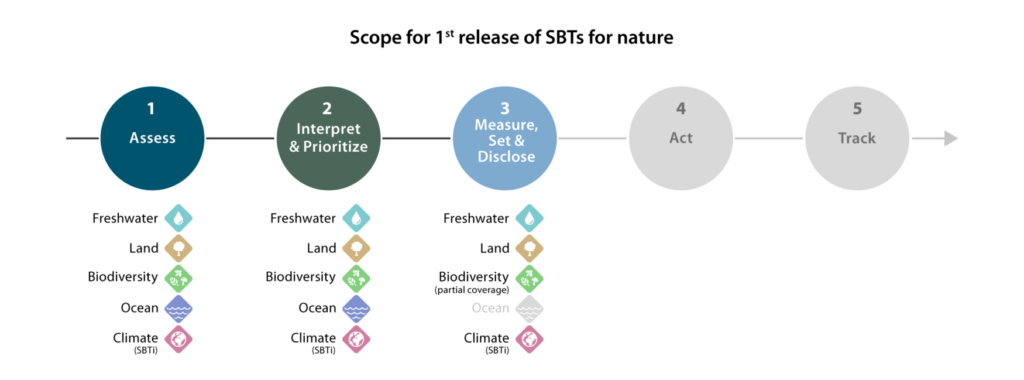
Following these global directives, biodiversity is slowly becoming a focal point in today’s corporate agenda. About a third of Europe’s largest companies have set biodiversity or deforestation targets. The adoption rates are lower, however, in Asia-Pacific and the U.S. For corporations with biodiversity goals, 56% aim to reach their goals in 2030, in line with the proposed COP15 timelines.
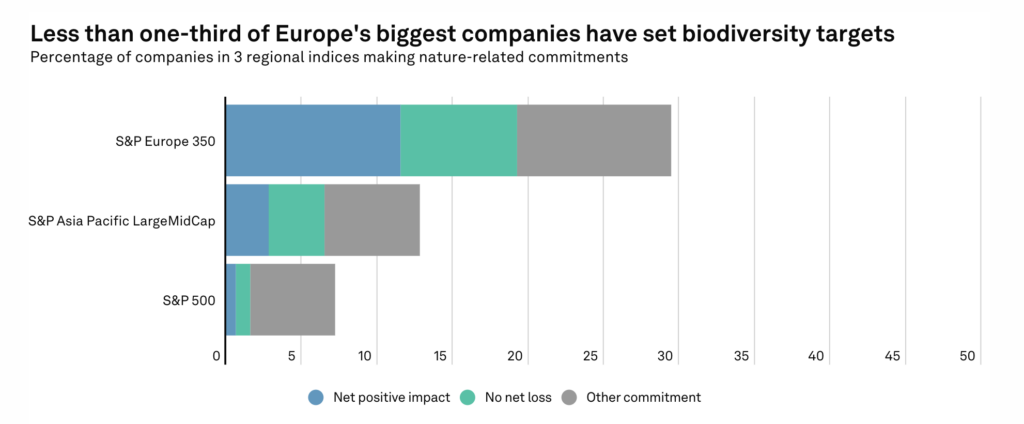
However, when it comes to tracking the impact of intricate supply chains, corporate biodiversity commitments often fall short and the scarcity of detailed data across various regions poses significant challenges. This is especially true with supply chains in developing countries. While there has been an increase in biodiversity observations globally, the capacity for monitoring is unevenly distributed across the world.
The majority of the world’s biodiversity resides in developing nations, yet data from just 10 countries, including the United States, Australia, South Africa, and seven European nations, comprises 82% of all available biodiversity records. In contrast, the remaining 18% of records come from all other countries combined. We have a long way to go.
Five Technologies Improving Biodiversity Monitoring and Data Collection
Earth’s wildlife population has dropped by almost two-thirds since 1970. Presently, there are around a million different species at severe risk of extinction, from large mammals like black rhinos and orangutans down to plants, insects, and fungi. Some of these at-risk species aren’t yet known to science, meaning we do not fully understand all that we are losing.
Many biodiverse-rich regions of the world do not have the tools or conditions needed for monitoring their biodiversity, such as data collection, visibility, quality, usability, and financial or technical capacity. Traditional biodiversity monitoring techniques are expensive and time-consuming, which often results in incomplete data and underestimated biodiversity risks of proposed projects.
In more recent years, a range of advanced measuring tools have been developed, yet data collection processes remain time-consuming. For example, gathering data for a 1000-hectare site can take up to two months before actual analysis can begin. This bottleneck underscores the need for further efficiency improvements, which maturing and emerging technologies can both address.
Below are five technology areas we have observed that can positively move the needle on data-enhanced biodiversity measurement:
- Environmental DNA (eDNA) collection and sequencing: This technique leverages short DNA sequences as “barcodes” to identify species. Metabarcoding, on the other hand, focuses on determining the composition of species within a sample, rather than individual species.
- Advancements in camera and sensor technologies: The deployment of interconnected remote cameras is expanding, offering a unique glimpse into wildlife behavior. Standardized metadata and shared protocols are essential for maximizing the potential of this technology.
- Crowdsourcing: Nature enthusiasts can actively contribute to ecosystem data collection through applications like iNaturalist and eBird. These mobile apps facilitate citizen science and engage a wider audience in biodiversity monitoring.
- Remote monitoring with satellites: Satellite technology provides a bird’s-eye view of changing landscapes. It enables us to monitor large-scale environmental changes, offering critical insights into the state of our planet.
- AI is improving biodiversity assessment by analyzing large data sets, identifying species from images through computer vision, creating ecosystem management software to prioritize conservation efforts, and streamlining land management processes for enhanced efficiency.
Startup Landscape: SaaS Comes to Biodiversity
SaaS has revolutionized the way we handle data, providing a cloud-based platform for collecting and analyzing data from multiple sources and giving scientists, companies, and regulators real-time, transparent information about the health and sustainability of various ecosystems.
Startups are at the forefront of biodiversity conservation, providing enterprise software solutions that enable businesses to make informed decisions, meet regulatory requirements, analyze data, and engage in nature restoration projects. Many of these innovative software approaches are enabling corporations to enhance their commitment to (and ability to act on) preserving biodiversity.
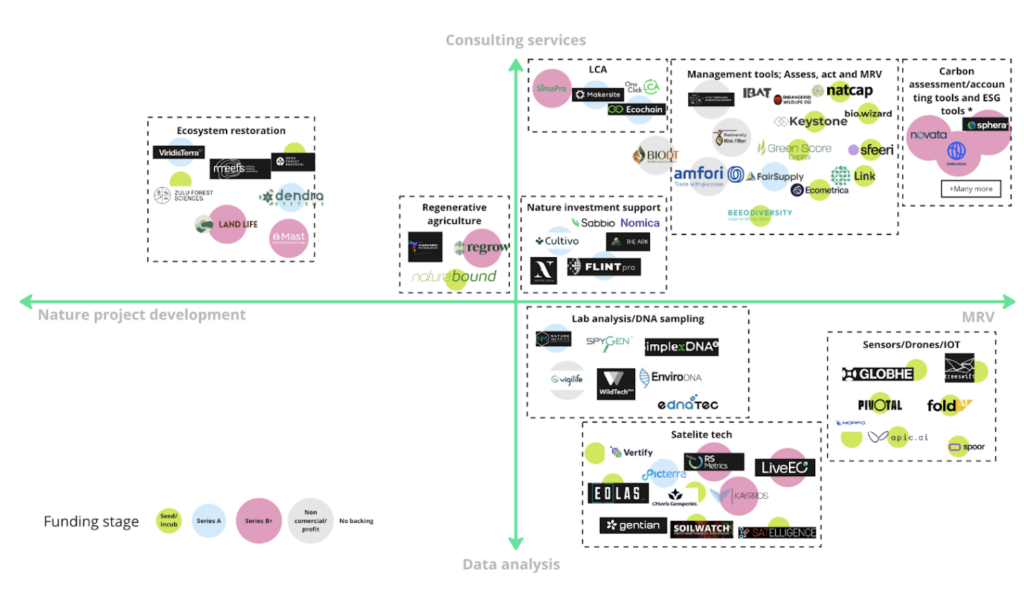
Below, we have mapped out relevant examples of biodiversity-focused SaaS startups categorized by their offering scope and technology focus areas:
Risk Management: These startups offer assistance in decision-making, regulatory compliance, risk assessment, and management.
- Startup Example: Link offers a Nature risk management software platform for companies that create the majority of their nature and biodiversity impact upstream in the supply chain. The platform supports companies in assessing, prioritizing, strategizing, and reporting on their impact on nature.
Data Analysis: Startups focused on collecting, aggregating, and analyzing biodiversity data.
- Startup Example: NatureMetrics offers a biodiversity monitoring platform designed to identify and quantify organisms in the natural environment. At the core is their eDNA metabarcoding technology.
MRV (Measurement, Reporting, and Verification): Specialized in ensuring data accuracy and reliability.
- Startup Example: Picterra operates a geospatial data platform that harnesses artificial intelligence to extract vital information and insights from satellite images, which enables clients to analyze and interpret aerial data on a large scale, customized to their industry needs.
Nature Project Development: These startups actively contribute to nature restoration efforts.
- Startup Example: Cultivo focuses on mobilizing financial resources to support the restoration of nature by curating portfolios of premium natural assets that not only yield strong financial returns but also benefit the environment and society.
Investing in Biodiversity’s Future
Protecting biodiversity is not only essential to the future of the planet, it’s fundamental to our economy and human well-being.
Advances in technology are providing a myriad of previously non-existent options for monitoring ecosystems and ensuring they’re safeguarded against the existential risks that human activity poses to the planet. In this way, for businesses and countries looking to protect their ecosystems while advancing their development agenda, today’s emerging landscape of tools is providing a pathway to better understanding and action that was previously not available.
Innovations hold the promise of deepening our understanding of biodiversity and guiding enterprises toward more effective conservation strategies. Pairing corporate commitments to global goals with the necessary tools for action and behavior change will be key as we protect the species, habitats, and ecosystems that sustain our lives on this ever-connected planet.
If you are a startup or expert in the space of biodiversity, we would love to hear about your solutions and research. Please contact our investment team at hello@valoventures.org.



